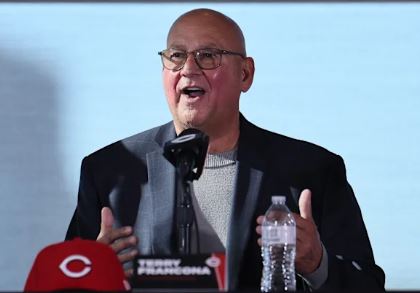
The 2016-2017 international signing period marked an unprecedented spending spree for the typically frugal Cincinnati Reds. They didn’t just exceed their $5.163 million bonus pool—they blew past it by nearly six times, handing out significant bonuses to shortstops Alfredo Rodriguez ($7 million) and Jose Israel Garcia ($5 million) as well as pitcher Vladimir Gutierrez ($4.75 million). This spending spree incurred about $12.5 million in overage penalties, bringing their total investment to roughly $30 million, with a clear focus on finding the franchise’s next cornerstone shortstop—a role left unfilled since the days of Davey Concepcion and Barry Larkin.
By the 2022 season, it seemed the Reds had finally succeeded. Jose Israel Garcia, who had changed his name to Jose Barrero in honor of his late mother, emerged as a top prospect. Ranked No. 33 on Baseball America’s Top 100 list, Barrero had shined during a stellar 2021 season, slashing .303/.380/.539 with 19 homers across Double-A and Triple-A. After continuing his hot streak in Triple-A to start 2022, he earned a call-up to the majors in August, only for his big-league debut to go disastrously.
Barrero’s struggles in the majors ultimately led to his departure from Cincinnati, with stints in the Rangers and Cardinals organizations that never fulfilled his once-lofty potential. However, the legacy of the Reds’ 2016-2017 signing class might be best remembered for what it forced the team to discover in its aftermath.
The Reds faced strict spending limits after their lavish spree, barred from signing players for more than $300,000 during the 2018 international period. This restriction led them to scout less conventional prospects. It was during this time that scouts Enmanuel Cartagena and Richard Jimenez revisited the Niche Baseball Academy in the Dominican Republic—an academy that previously produced Juan Soto. There, they found a raw, skinny, switch-hitting 16-year-old with a cannon for an arm. His unrefined skillset fit within their limited budget, and on July 18, 2018, they signed Elly De La Cruz for just $65,000.
:no_upscale()/cdn.vox-cdn.com/uploads/chorus_asset/file/25741018/2182154266.jpg)
Listed at a lean 6’2” and 150 pounds, De La Cruz displayed speed, arm strength, and a projectable frame. Still, no one could have predicted his meteoric rise. By 2022, while Barrero was penciled in as Cincinnati’s shortstop of the future, De La Cruz—now a towering 6’6”—had become a universal Top 100 prospect. His reputation grew as a powerful shortstop capable of hitting 500-foot home runs, sprinting faster than anyone on the bases, and throwing 100 mph darts across the diamond.
Elly’s development wasn’t immediate. He sat out the 2020 season due to the COVID-19 pandemic, but emerged from that break stronger, taller, and more skilled. After a modest start in the Dominican Summer League, he exploded onto the scene in 2021, earning a spot on Top 100 prospect lists and cementing himself as a future big-league star.
By 2024, De La Cruz’s first full MLB season at age 22, his extraordinary tools captivated fans and analysts alike. Statcast data—tracking metrics like foot speed, arm strength, and exit velocity—showcased his unique abilities, solidifying his status as one of the game’s most electrifying young stars. From a modest $65,000 signing bonus to becoming a Statcast marvel, Elly De La Cruz has become a symbol of the Reds’ unconventional yet successful scouting approach.
You might argue that sprint speed is meaningless without smart baserunning, that exit velocity is just a number if the ball doesn’t clear the fence, or that arm strength is irrelevant if throws miss their mark. Baseball has never been a game where raw athleticism alone guarantees success. Yet, it’s this intersection of talent and skill where the rising legend of Elly De La Cruz is taking shape.
Elly wasn’t just one of the top three fastest baserunners in 2024; he led Major League Baseball with 67 steals. His 102 combined steals since the start of the 2024 season also rank first. During his 2023 debut, his 119.2 mph max exit velocity placed him in the top 1% of hitters, and in 2024, his 71 extra-base hits tied him for 11th alongside stars like Yordan Alvarez and Anthony Santander. Though his 29 errors were the most in the league last year, his 15 Outs Above Average indicate that his range and arm were tested on plays most players wouldn’t have even attempted.
Like any 22-year-old adjusting to the big leagues, there’s room for improvement. He struck out 219 times in 696 plate appearances, the most of any player, and his error count drew criticism. Yet, FanGraphs ranked him as the 9th most valuable player of 2024 with a 6.4 fWAR, underscoring his immense potential. His flaws, while apparent, are likely to diminish as he gains experience.
:no_upscale()/cdn.vox-cdn.com/uploads/chorus_asset/file/25742278/1496941714.jpg)
What we saw in 2024 wasn’t peak Elly De La Cruz—it was just the beginning.
In becoming MLB’s first-ever 20-60 shortstop with 25 homers and 67 steals, Elly set a new standard. Achieving a 30-70 or even 40-80 season now seems within reach for Cincinnati’s franchise cornerstone, offering Reds fans a reason to dream as the 30th anniversary of their last postseason series win approaches.
If anyone can bring the Reds back to relevance, it’s Elly De La Cruz, whose rare combination of power, speed, and defensive prowess has the baseball world officially paying attention.
Leave a Reply